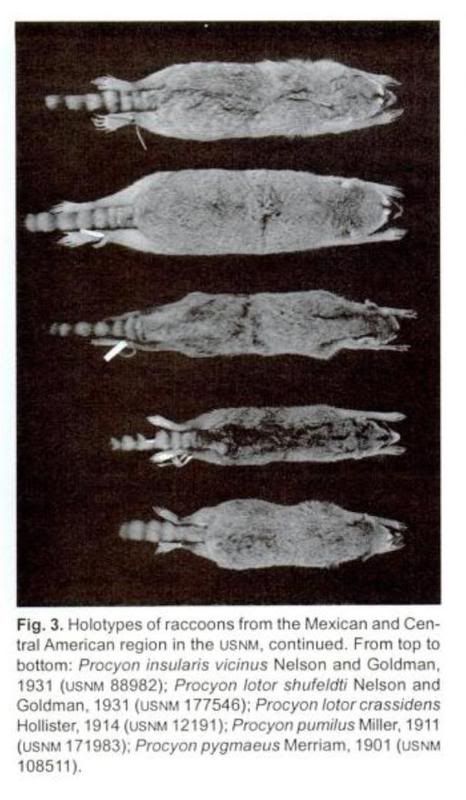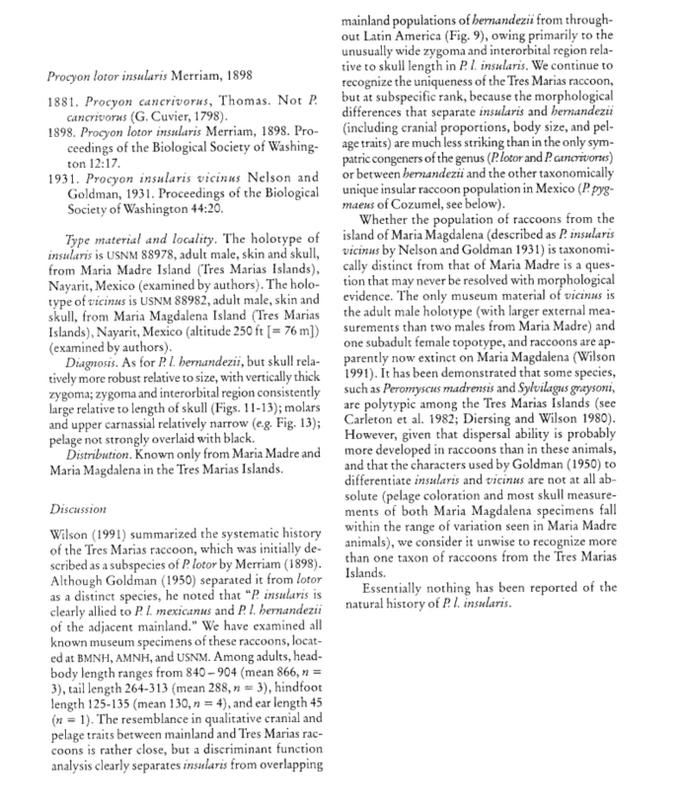|
|
Post by another specialist on Aug 9, 2008 16:09:50 GMT
 Contribuciones mastozoológicas en homenaje a Bernardo Villa By Víctor Sánchez-Cordero, Víctor Sánchez-Cordero Rodrigo A Medellín, Rodrigo A Medellin |
|
|
|
Post by another specialist on Aug 9, 2008 16:17:00 GMT
 Contribuciones mastozoológicas en homenaje a Bernardo Villa By Víctor Sánchez-Cordero, Víctor Sánchez-Cordero Rodrigo A Medellín, Rodrigo A Medellin |
|
|
|
Post by another specialist on Aug 9, 2008 16:21:26 GMT
 Contribuciones mastozoológicas en homenaje a Bernardo Villa By Víctor Sánchez-Cordero, Víctor Sánchez-Cordero Rodrigo A Medellín, Rodrigo A Medellin |
|
|
|
Post by another specialist on Aug 9, 2008 16:25:55 GMT
 Contribuciones mastozoológicas en homenaje a Bernardo Villa By Víctor Sánchez-Cordero, Víctor Sánchez-Cordero Rodrigo A Medellín, Rodrigo A Medellin |
|
|
|
Post by Melanie on Aug 9, 2008 16:29:02 GMT
unlikely extinct as it still occurs on Maria Madre The Tres Marias Raccoon mainly is on two of the three islands, Maria Madre Island and Maria Magdalene Island. On Maria Madre it is thought that there are around 250 total but it is believed to be fully eradicated on Maria Magdelane. itech.pjc.edu/sctag/Tres_Marias_Raccoon/index.htm |
|
|
|
Post by another specialist on Aug 9, 2008 16:32:58 GMT
unlikely extinct as it still occurs on Maria Madre The Tres Marias Raccoon mainly is on two of the three islands, Maria Madre Island and Maria Magdalene Island. On Maria Madre it is thought that there are around 250 total but it is believed to be fully eradicated on Maria Magdelane. itech.pjc.edu/sctag/Tres_Marias_Raccoon/index.htmThe Tres Marias raccoon (Procyon insularis) is a species of raccoon found on the two main islands of the Islas Marías, an archipelago off the western coast of the Mexican state of Nayarit.[1] A majority of scientists considers it to be a distinct species and not a subspecies of the common raccoon (Procyon lotor). [edit] Description The average body length of five adult males, including the tail, was stated with 84.1 cm (33.1 in) by explorer E. W. Nelson in 1898.[2] Of the same tenor, zoologist Samuel I. Zeveloff calls the Tres Marias raccoon large in comparision with the common raccoon, making it not an example of insular dwarfism. The coat of the Tres Marias raccoon is pale and short and its prominent skull is more angular than that of the common raccoon. [edit] Conservation In 1996, the Tres Marias raccoon was classified as endangered by the IUCN because less than 250 mature individuals were living in the wild.[3] The subspecies Procyon insularis vicinus, found on the María Magdalena island, is assumed to be extinct. The Tres Marias raccoon is hunted by the islanders and no conservation efforts have been made to protect the species from extinction. Considering its small range, the Tres Marias raccoon was most likely never numerous, just as well as the other island raccoons (Cozumel raccoon, Gouadeloupe raccoon, Bahaman raccoon and the extinct Barbados raccoon). It is also assumed that all island raccoons are quite recent arrivals to their islands. |
|
|
|
Post by another specialist on Aug 9, 2008 16:35:06 GMT
|
|
|
|
Post by another specialist on Aug 9, 2008 16:36:54 GMT
unlikely extinct as it still occurs on Maria Madre The Tres Marias Raccoon mainly is on two of the three islands, Maria Madre Island and Maria Magdalene Island. On Maria Madre it is thought that there are around 250 total but it is believed to be fully eradicated on Maria Magdelane. itech.pjc.edu/sctag/Tres_Marias_Raccoon/index.htmP. i. insularis is the subspecies your mentioning . Yes this subspecies is still alive but not what this thread is about. |
|
|
|
Post by Melanie on Aug 9, 2008 23:01:52 GMT
I still disagree, because MSW 3 (2005) iconsidered all Island races (Tres Marias, Cozumel, Barbados etc.) of the Raccoon as Island subspecies (or races) of Procyon lotor. And vicinus is just a synonym of Procyon lotor insularis. And another thing: Maria Madre Is. and Maria Magdalena Is. are only 12 kilometres apart and as it is assumed that all island raccoons were problably artificially introduced on these islands in pre colombian times i don't think that these populations are distinct enough to see them as subspecies. www.bucknell.edu/msw3/browse.asp?id=14001676 |
|
|
|
Post by Melanie on Aug 9, 2008 23:32:52 GMT
In its initial description in 1898, the Tres Marias raccoon was classified as a subspecies of the common raccoon (Procyon lotor) by Clinton Hart Merriam.[2] In 1950, Edward Alphonso Goldman identified it as a distinct species; a view that has been upheld by most scientists until recently. In a study of a couple of mounted speciemen in 2005, Kristofer M. Helgen and Don E. Wilson came to the conclusion that there are morphological differences between the Tres Marias raccoon and the subspecies Procyon lotor hernandezii of the common raccoon found on the Mexican mainland, but that they are not large enough to justify the classification as distinct species. It is therefore assumed that the Tres Marias raccoon was introduced to the Islas Marías not long ago. Subsequently, the Tres Marias raccoon was listed as a subspecies of the common raccoon in the third edition of Mammal Species of the World by Wilson and DeeAnn M. Reeder published in 2005.[3] en.wikipedia.org/wiki/Tres_Marias_Raccoon |
|
|
|
Post by another specialist on Aug 10, 2008 7:47:24 GMT
Smithsonian National Museum of Natural History Procyon insularis # Author........ : Merriam, 1898. # Citation...... : Proc. Biol. Soc. Washington, 12:17. # Common Name... : Tres Marias Raccoon # Original Name. : Procyon lotor insularis Merriam, 1898. # Distribution.. :María Madre Isl (P. i. insularis), and María Magdalena Isl (P. i. vicinus). # Type Specimen. : USNM 88978; skin and skull of an adult male. # Type Locality. :"Maria Madre Island, Tres Marias Ids., Mexico." nmnhgoph.si.edu/cgi-bin/wdb/msw/names/query/12365 |
|
|
|
Post by another specialist on Aug 10, 2008 7:58:41 GMT
|
|
|
|
Post by another specialist on Aug 10, 2008 8:00:08 GMT
The above is in PDF form but is from a book
More details
The Red Panda, Olingos, Coatis, Raccoons, and Their Relatives: Status Survey and Conservation Action Plan for Procyonids and Ailurids
By A. R. Glatston, IUCN/SSC Mustelid, Viverrid & Procyonid Specialist Group
Published by IUCN, 1994
ISBN 2831700469, 9782831700465
103 pages
|
|
|
|
Post by another specialist on Aug 10, 2008 8:09:54 GMT
Even if no longer valid and there is still disagreement in the scientific world on its status it's definitely an extinct population which means it has a place here in the forum in this category.
|
|
|
|
Post by another specialist on Aug 10, 2008 8:29:21 GMT
Even if no longer valid and there is still disagreement in the scientific world on its status it's definitely an extinct population which means it has a place here in the forum in this category. I've contacted the IUCN Small Carnivore Specialist Group to find out more on this Raccoon and the Barbados Raccoon as well. |
|